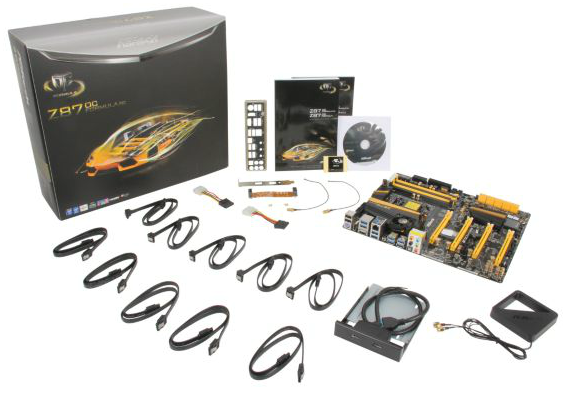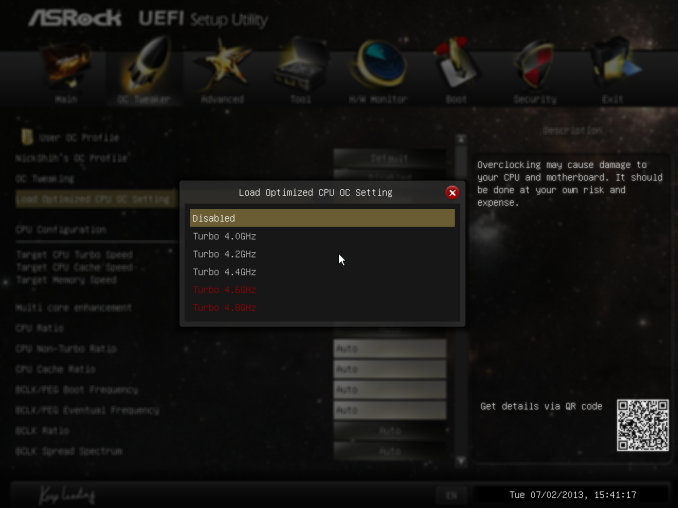ASRock Z87 OC Formula/AC Review
by Ian Cutress on July 26, 2013 10:00 AM EST- Posted in
- Motherboards
- ASRock
- Haswell
- Z87
ASRock Z87 OC Formula/AC In The Box
Getting a large set of extras in the box with a motherboard, from my perspective given my opportunity to shuffle through a fair few, is that these extras give a sense of added value. If you purchase a low-priced motherboard with a lot of extras, it is a good feeling due to the unexpected nature, and vice versa. Undoubtedly when spending $300+ on a motherboard, a lot of kit in the box needs to be as standard, otherwise it will turn reviewers off the product as a whole (unless the SKU was an OEM-type production at a cheaper cost). With the Z77 OC Formula the highlight was the OC Formula bag and additional plastic standoffs for overclockers, with the latter probably costing less than $0.03 in terms of overall cost for the manufacturer. The Z87 OC Formula tries something similar:
Rear IO Shield
User Manual
Driver CD
OC Formula Sticker
Two molex-to-SATA connectors
10 SATA Cables
USB 3.0 Front Panel and Rear Bracket
Antenna and Connectors
Flexi SLI Bridge
OC Formula Bag
Gelid GC-Extreme Thermal Paste
Plastic Standoffs

ASRock Z87 OC Formula Overclocking
Experience with ASRock Z87 OC Formula
The ASRock overclock experience has definitely evolved over the generations, especially in terms of a 24/7 stable system alongside all the extreme overclocking options. As such, using the automatic overclock options (3 in OS, 5 in BIOS), they are all very simple in terms of click and go, as well as telling the user what they do.
For a manual overclock, having such extensive automatic overclock options at least helps new users gain a feel for what options should be used to help with basic manual overclocking. On our CPU sample we hit the CPU limit on ambient cooling as quickly as we did on previous Haswell motherboards, giving 4.5-4.6 GHz at a reasonable voltage before high temperatures kick in. Users will have to maintain strict observation of their overclocks, because by default the OC Formula will reduce clocks if temperatures get too high.
In terms of memory, we were easily able to boost a G.Skill DDR3-3000 C12 memory kit to 3150 MHz in terms of peak performance, whereas other extreme overclockers who know substantially more about memory than I do have seen 3400+ MHz on air or 4000+ MHz under sub-zero conditions.
Methodology:
Our standard overclocking methodology is as follows. We select the automatic overclock options and test for stability with PovRay and OCCT to simulate high-end workloads. These stability tests aim to catch any immediate causes for memory or CPU errors.
For manual overclocks, based on the information gathered from previous testing, starts off at a nominal voltage and CPU multiplier, and the multiplier is increased until the stability tests are failed. The CPU voltage is increased gradually until the stability tests are passed, and the process repeated until the motherboard reduces the multiplier automatically (due to safety protocol) or the CPU temperature reaches a stupidly high level (100ºC+). Our test bed is not in a case, which should push overclocks higher with fresher (cooler) air.
Automatic Overclock:
For our automatic overclock testing, we start in the OS using the Formula Drive software. The front screen of this software offers several options – Standard, Power Saving, and Performance. The Performance setting also opens up the Auto Tuning Menu.
On the standard setting, meaning everything at default, we saw a PovRay score of 1612.8, OCCT peak temperature of 68C (high ambient temperature in the British summer with no AC) and a load voltage of 1.160 volts.
Under the Power Saving setting, the system reduces the CPU multiplier to 8x and then requires several seconds of full loading to slowly add multipliers eventually reaching full turbo speed. This helps keep the CPU in low power states for short work, but giving long multithreaded performance a small deficit in the short term. With this setting, the system scored 1507.14 in PovRay, 70C peak in OCCT, and 1.160 volts under load.
In Performance mode the system is placed in its max turbo mode all the time, even in idle. This gives a score of 1603.27 in PovRay, 72C peak in OCCT and 1.160 volts under load.
Using the Auto Tuning option, the system started at 3.0 GHz before stress testing the system and finally finishing at 4.3 GHz. At this setting, we get a score of 1760.15 in PovRay, 83C peak in OCCT and 1.288 volts under load.
The BIOS also has automatic overclock options, under the ‘Optimized CPU OC’ setting. This offers five overclocks from 4.0 GHz to 4.8 GHz in 200 MHz increments.
At 4.0 GHz, the system applied a +0.020 volts offset in adaptive mode while leaving VRIN and LLC on Auto. At this setting, PovRay scores 1649.72, 64C peak in OCCT and 1.080 volts under load.
At 4.2 GHz, the system applied 1.200 volts in static mode while leaving VRIN and LLC on Auto. At this setting, PovRay scores 1735.47, 76C peak in OCCT and 1.216 volts under load.
At 4.4 GHz, the system applied 1.300 volts in static mode while leaving VRIN and LLC on Auto. At this setting, PovRay scores 1823.90, 90C peak in OCCT and 1.304 volts under load.
At 4.6 GHz, the system applied 1.320 volts in static mode, a VRIN of 1.900 volts and LLC to Level 1. At this setting, PovRay scores 1900.28, 95C peak in OCCT and 1.328 volts under load.
At 4.8 GHz, the system applied 1.400 volts in static mode, a VRIN of 1.900 volts and LLC to Level 1. At this setting, PovRay scores 1844.54 (suggesting the system is throttling), OCCT caused a BSOD and load voltage was measured at 1.408 before the BSOD.
Manual Overclock:
Using the previous experience of overclocking on this CPU and the automatic overclocking results, we started at 1.000 volts and 40x100 with the CPU. When a setting was unstable the voltage was raised 0.025 volts, and when the setting was stable, the multiplier was raised. This was repeated until temperatures became too high. Results are:













22 Comments
View All Comments
Sabresiberian - Friday, July 26, 2013 - link
I like the idea of a conformal coating, but ASRock needs to have done its homework thoroughly. Such a coating can actually cause components to fail because the rise and fall of temperatures flexes the component parts and solder joints as the coating literally pulls the components down when the system gets colder. This can happen at relatively normal temperature ranges, bringing board components down to temps they might see with a little spilled LN2 makes it even more critical. That being said, it is probably less of an issue now than it was 30 years ago when I was involved in the testing of conformal coatings on circuit boards. :)I wouldn't let it stop me from buying the board, as I say I like the idea, but it would be in the back of my mind if I did. It IS a great idea to protect the mainboard from the effects of condensation or a leak in a water cooling system. A +1 in my book for ASRock.
GuardianAngel470 - Saturday, July 27, 2013 - link
It seems to have been a while since you last looked at conformal coatings. The ONLY artificial coating I know of described as Superhydrophobic is Neverwet, a recent advancement in nanotechnology.It can be applied to clothing, fabrics, metals, plastics, and a heck of a lot else without the need for restrictive layers like previous coatings. It's more like a paint than a coating.
owan - Monday, July 29, 2013 - link
There are lots of treatments that can be described as "superhydrophobic" other than Neverwet, which is just a brand name. It could be one of several different nano-structures, silicones, or fluorochemicals. Extremely hydrophobic materials are not newzero2dash - Friday, July 26, 2013 - link
Dat LCD....that is some neat stuff. I hope to see Gigabyte do something similar in the future.buzznut - Tuesday, July 30, 2013 - link
I have to agree, I've only bought two motherboards over $200, one was an ASUS Crosshair 1 that never worked right and the Asrock Z77 OC formula which is in RMA right now. Both of which tech support is almost non-existent.I will certainly think twice before ordering another mobo over $200. I am an enthusiast and modder, but it just doesn't make sense to spend that much money when I've had $100 motherboards that are still in service after 5 years.
Hrel - Friday, July 26, 2013 - link
Lol $330. If you spend over 200 on a motherboard you're an idiot.If you spend over 150 you don't care about value.
Competitive overclockers excluded from "idiot" category. It's ok to be frivolous on a hobby.
Slash3 - Saturday, July 27, 2013 - link
So, what you're saying is that it's priced just fine for the features it delivers?tech6 - Monday, July 29, 2013 - link
+1So called enthusiast boards are mostly a waste of money. There are few commonly run apps that significantly benefit from CPU or memory overclocking. For that sort of money you'd be better off with a second graphics card or an SSD.
iTzSnypah - Friday, July 26, 2013 - link
Please please learn to overclock Haswell. You are killing the potential of these reviews with novice overclocking.When an automatic overclock uses the same CPU voltage as your manual overclock to reach 4.6Ghz you know you are doing something wrong.
Razorbak86 - Saturday, July 27, 2013 - link
"As a competitive overclocker myself, I find this hobby of mine absolutely fascinating. I have had some mild success personally, hitting near the top of the enthusiast league for several years, achieving success in local competitions and I currently hold a number of UK records. I joined HWBot before I really got into enthusiast hardware, and through HWBot I joined the local UK team and luckily I had a chance encounter at a Gigabyte overclocking event with an AnandTech editor which started my writing career." - Ian Cutresshttp://www.anandtech.com/show/7081/competitive-ove...
Just out of curiosity, how many overclocking records do you hold?